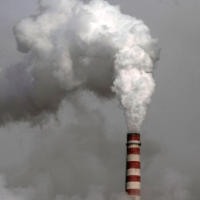One-Week Until Energy Market Launch, and Polluters Are Still Fighting for Discounts
 Coal-fired plant (photo: Associated Press)
Coal-fired plant (photo: Associated Press)
California is poised to open the world’s second-largest carbon market, in an effort to cap greenhouse gas emissions and lower pollution levels to the 1990s, but opponents are still fighting for fundamental changes days before launch.
The market will allow 350 industrial businesses with 600 facilities―including steel mills, refineries, utility companies and other big polluters―an opportunity to trade pollution credits. Participants receive an allocation of credits from the state based on past emissions, and can profit or suffer financially based on their future emissions. Cap and trade is the centerpiece of California’s effort to reduce greenhouse gases.
Europe operates a similar 30-nation market and markets are underway in China, Japan and other countries. Nine northeastern U.S. states participate in a market aimed at cutting carbon emissions. Republican New Jersey Governor Chris Christie pulled his state out of the market last year.
The AB 32 Implementation Group, named after the 2006 global warming legislation that included provisions for a cap and trade auction, predicts a “grave and destructive effect on California’s regulated businesses” if the state insists on only giving participants trading credits for 90% of their recent emissions. They want 100%.
The industrial and business coalition petitioned the governor to delay the auction’s start and change that rule and others, or consumers and businesses would face a “draconian and unnecessary burden.”
The market is being overseen by the California Air Resource’s Board, which will sell 21.8 million credits to cover emissions in 2013 and 39.5 million credits for 2015. The state hopes to make hundreds of millions of dollars from initial allocations of credits and use the marketplace to provide incentives for companies to cut pollution.
The cap and trade program has also received criticism from environmental justice groups, who fear that the state’s largest pollution emitters, like refineries and utilities, will be able to buy their way out of compliance by manipulating the system. They tend to prefer a more direct system of mandating the use of specific equipment, or assigning specific pollution limits to individual companies and forcing them to comply.
Legal challenges are expected from multiple interests, including out-of-state energy producers and those who think the state shouldn’t be handing out any offset-credits to begin with.
–Ken Broder
To Learn More:
Auction to Kick-Start California Carbon Market (by Rory Carroll, Reuters)
California's First Auction of Greenhouse-Gas Credits Nears (by Marc Lifsher, Los Angeles Times)
AB 32 Lawsuit: Assessing the Environmental Justice Arguments Against Cap and Trade (by Ann Carlson, Legal Planet)
State Ponders Spending Millions to Keep Polluters in Largely Unknown Cap-and-Trade Program (by Ken Broder, AllGov California)
- Top Stories
- Controversies
- Where is the Money Going?
- California and the Nation
- Appointments and Resignations
- Unusual News
- Latest News
- California Forbids U.S. Immigration Agents from Pretending to be Police
- California Lawmakers Urged to Strip “Self-Dealing” Tax Board of Its Duties
- Big Oil’s Grip on California
- Santa Cruz Police See Homeland Security Betrayal in Use of Gang Roundup as Cover for Immigration Raid
- Oil Companies Face Deadline to Stop Polluting California Groundwater





